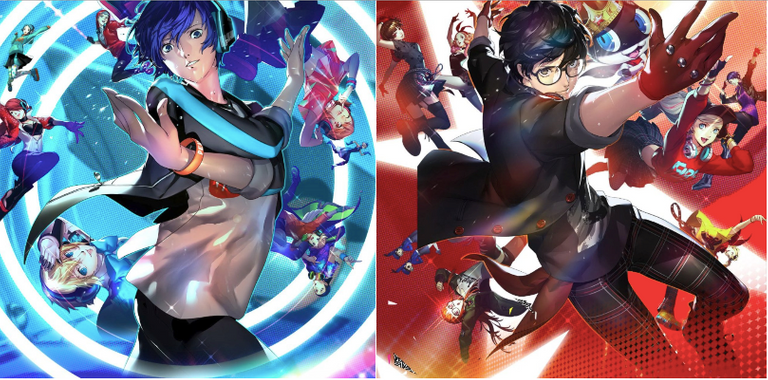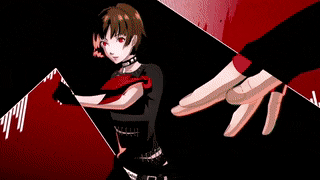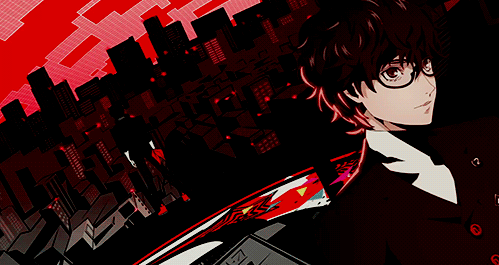Warning: mild spoilers for Persona 4 and Persona 5 ahead, particularly surrounding which characters join the Investigation Team and the Phantom Thieves respectively. I also jab at some Persona 3 spoilers, but you don't have to worry if you don't know what I'm talking about. Finally, I'm going to discuss the premise of Persona 5: Dancing in Starlight, but this really isn't the type of game that you worry about spoilers for.
Hey guys, it's been a while! These past few months have been a crazy time for me, as I've traveled to visit family and started college. I'd like to get back into writing in my free time again, but I do want to focus on my longer essays rather than the more frequent short form pieces I did before I left. So, what better way to properly get back to my roots than to talk about Persona 5 again?
In the past I've written a couple essays about Persona 5, particularly its intros. I first did one discussing Persona 5 Royal, and then another discussing Persona 5 Scramble. In both cases, I talked about the intros in the context of the original and the unique elements of each used to achieve different goals. They're still two of my favorite pieces I've done, and I highly recommend giving them a read if you have an active interest in the topic, the game, or animation.
So then over the summer I bought Persona 5: Dancing Star Night. Dancing in Starlight is not an RPG like Persona 5 or Royal, and it does not hope to properly continue the story of the original like Scramble. It is a spinoff in the purest sense. But it's also canon sort of? And so is Dancing in Moonlight, the Persona 3 dancing game? I haven't played Persona 3, but I know how that game goes down and right from the get-go I have no idea how that makes any sense. It doesn't matter too much though, because it's clear you're not really supposed to take it seriously. Just look at the dancing teens and go King Crazy man.

The plot of Persona 5: Dancing in Starlight is that while the Phantom Thieves are asleep, Caroline and Justine call them to the Velvet Room to participate in a dancing competition. It's a dream, so the characters just get to let loose and have a good time. However, it does have its own anime intro. So, let's look at how it sets itself apart from its more serious counterparts.
It is important to first establish another intro that had an influence on this one: the intro to Persona 4: Dancing All Night. All Night is the predecessor to both Starlight and Moonlight, and has an intro of its own. It's not nearly as clean as the latter two, but it is years older and was made for the significantly smaller screen of the Vita.
All Night is most significant in talking about Starlight in how it introduces its characters. To do this, it draws heavily from the openings of Persona 4 and Persona 4 Golden (Persona 4's deluxe version came before its Dancing game, unlike with Persona 5). Particularly, it mimics Golden's character introductions of having each character's name displayed while they dance in a way that is reflective of their personality, with an added touch of being accompanied by song lyrics in the background reflective of the introductions in Persona 4.
Once all of the characters are introduced, they get an extended dancing sequence where they have a moment in the spotlight before transitioning to the next person, and then ending with everyone dancing together. Persona 5 does not introduce its characters through individual title cards, instead opting to show its characters in motion. Since Persona 5 does not use the title card format seen in Persona 4 and instead introduces its characters in motion, Starlight does the same by properly introducing the personalities of the characters through a dance sequence where characters trade off the spotlight not unlike what it seen at the end of All Night's intro. The sequence shows the dancers playing off of each other and interacting in the same space, lending itself more to introducing these characters as a unit rather than their separate parts. By doing this near the beginning rather than right at the end, Starlight more quickly establishes the characters as a team, which is how they're represented for the rest of the intro's length.

The main emphasis throughout the entire intro is seeing all of the characters as an ensemble doing things together, with several scenes of the ensemble dancing as an ensemble rather than just one. Actually, one of these scenes would seem to be a direct homage to that last shot in All Night, with the camera tracking the dancers rather than staying in one static spot, and with everyone dancing on a stage incredibly similar to All Night's. However, they also get to hang out on and jump off of rooftops, and dance together in other locations like a subway train. This ensemble lens carries forward in the intros of Royal and Scramble. Royal follows the same format of introducing its characters through a scene rather than a splash card, and while Scramble does have splash cards for its characters, the characters trade off with each other rather than existing in their own space. We also see much more of the characters directly interacting as a group.
During one particular scene near the end, the ensemble all dances together as the intro shows off a few of the places the characters dance in the game. This does stand out in the line of Persona 5 intros as they don't typically go out of their way to establish specific locations like this. All Night doesn't seem to establish a setting at all other than an abstract colorful city and the more traditional-looking dancefloor of the ending shot.
Another interesting point about Starlight's intro is that it puts a heavier focus on pairs. In the scene where the Thieves are hanging out on the rooftop, and in the subsequent scene where the characters are dancing in the subway, they seemed to be paired up: Ryuji with Ann, Makoto with Yusuke, Futaba with Haru, and Joker with Morgana. So in addition to the intro placing a focus on the team as a whole, it also seems to specifically reference the partner mechanic in the game where if the player gets a high enough combo, they can be joined by a second dancer for a small portion of the song.

In these ways, Starlight draws attention to its game mechanics throughout the intro. It could be said that Royal dabbles in this a little with a quick high-five shot referencing the Baton Pass overhaul, but for the most part the original intro and its deluxe counterpart focus more on setting up the characters and the set-up of the game. However, it is worth noting that Scramble, after following a similar pattern to the original and Royal for most of its run, decides to dedicate a large portion to an extended action sequence showcasing the new combat system. While the game is a sequel to Persona 5, it is also a spin-off, and thus it lends itself to both styles of information presentation.
That's not to say that Starlight never draws from the original intro in its methods of conveying information. The intro's opening shot actually is heavily reminiscent of the original game's. We start off with a red sky and the cityscape popping into view. However, Starlight's cityscape is rendered in 2D, and is colored with gradients rather than the flat coloring we see in the original. Also, there's rainbow confetti. Immediately, this intro is signifying that it is going to be respecting the original pallet, while still straying from it to a large degree. This makes sense, as it is a spin-off. It also make sense to lean into the red color pallet as a way to distance itself from the simultaneously released Moonlight, which in turn leans heavily into Persona 3's blue color pallet.
From here, we get this very interesting introduction to our beloved cast of characters. The shot has each one spinning around a disc, with two versions of the characters on either side. The version that faces us is them in their traditional school outfit, and on the other side they are seen in their dancing outfits. The city surrounds them, looking almost identical to the city seen in the original game at the beginning of each day. The dancing versions of the characters are rendered in the same pallet used for the characters in the original intro. And stranger yet, the clouds in the sky have this strange pixel grid look to it, simulating clouds while also looking completely artificial.

This intro does a great job from the start of hinting at the game not taking place in reality, at least as we know it in Persona 5. The choice of the city that the player typically sees as Joker is dreaming in the game especially adds to the idea that this is a dream. It is also one specifically constructed by Caroline and Justine. Interestingly, in the original intro, the characters were confined to the limited color pallet of the world around them with minimal accents, and thus had to express their individuality through their actions. Here, they maintain their own sense of individuality and are being asked to conform to this new game the Velvet Room ladies have cooked up. In the game, the characters actually dance by just imagining themselves dancing, and not by their actual abilities. So, these dancing versions are not even really the characters themselves, but rather, dare I say it, their dancing personas. It's all in good fun of course, but the game does do a great job at establishing this more detached nature to this game's mechanics by using visual elements from the first game.
In addition, the game heavily draws from the intro of the original in perhaps its most memorable and visually striking shot: Joker effortlessly gliding through lines of moving trains, cars, and crowds of people.

In the original Persona 5 there are two separate shots where characters dance in the middle of the street. At the beginning Joker is by himself, with the shot acting as his introductory act of rebellion; at the end, he's joined by Ann, Yusuke, Ryuji and Morgana. You don't see any cars on the street, but this dancing is still seen as directly defiant and risky. Here, there is an direct, active danger to Joker's life, and he moves through it without a care in the world. In Persona 5's intro we see his confidence, but it is fully realized here (which makes sense, as this game takes place after the events of the original game). Joker is not only directly confident in the face of danger now, but is also displaying self-expression in the face of the world at large, asserting himself as an individual and more openly rebelling against the status quo. After all, dancing is all about self-expression. Perhaps that's why they use it in Persona openings so much, with Kasumi's introduction in Royal directly following in Joker's footsteps by having her dance in the midst of a crowd of silhouettes.
So, Dancing in Starlight does build off of the original intro, like Royal and Scramble to follow. However, Starlight does establish the Phantom Thieves as a group, the introduction of game mechanics, and the liberty with the color pallet that could later be seen in these subsequent titles. Therefore, we shouldn't write off this intro along with its game as the black sheep of the Persona 5 catalog. While yes, the focus is on fun, the intro manages to do that while also bringing a lot to the table.

Hey guys, I hope you enjoy this piece! Out of my works, this is definitely tied with my piece on Genius Lyrics for being the longest and taking the most time. I ended up rewriting a bunch and restructuring the flow to make it more cohesive, and it still ended up being almost two thousand words. I definitely didn't expect to have this much to say about the game, but that's how the cookie crumbles!
Congratulations @paigeautumneve! You have completed the following achievement on the Hive blockchain and have been rewarded with new badge(s) :
You can view your badges on your board and compare yourself to others in the Ranking
If you no longer want to receive notifications, reply to this comment with the word
STOPDo not miss the last post from @hivebuzz: